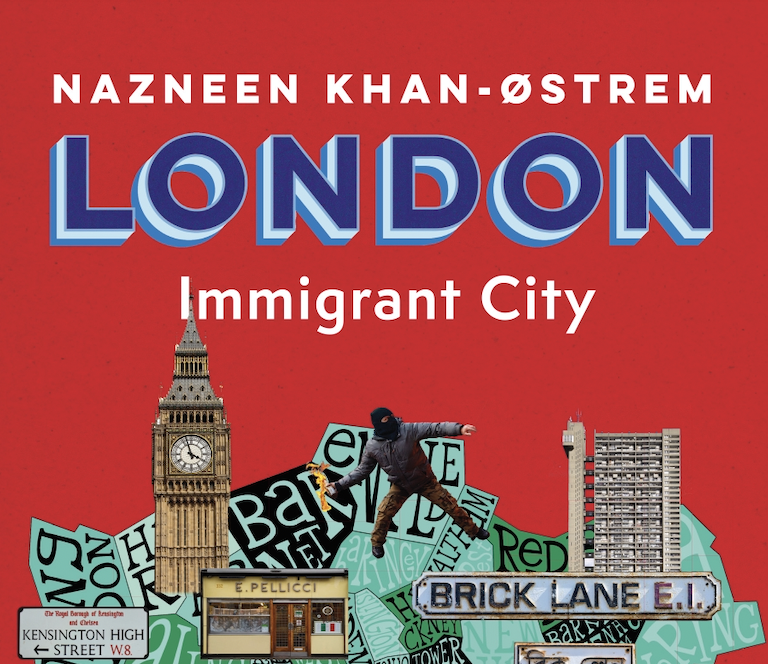Post
BOOK REVIEW | London: Immigrant City
3 Jul 2023
By
Nazneen Khan-Østrem
Published by Little, Brown book group
Reviewed by Clare Delmar
I was immediately attracted to this book for several reasons: First, the author’s name. Nazneen Khan-Ostrem. Its inhabitant would very likely know her stuff and offer a perspective based on personal experience. As an immigrant myself to this fair city, a fellow traveller’s account was interesting to me.
I grew up in an immigrant city on America’s east coast where the narrative on immigration was carved into the base of the Statue of Liberty – "Give me your tired, your poor, your huddled masses yearning to breathe free, the wretched refuse of your teeming shore”. Ethnic groups stuck together in neighbourhoods setting up their schools, churches, sports clubs etc, and – crucially – immediately defined themselves with a hyphen. Irish-Americans, Italian-Americans, and Asian-Americans all melted into the big American pot of culture. African-Americans, of course, had a different experience.
Check out the Society’s current rundown of upcoming events
London is very different in its immigration history, and this is reflected in its neighbourhoods and communities. Much of this has to do with the Empire, which drove the flow of many immigrants to London. Unlike the hyphenated Americans, many immigrants to London proudly wear their ethnic identity comfortably alongside their identity as Londoners.
I was reminded of this late last year when a media storm erupted over the question “Where are you from”. Opinions varied on the etiquette of this question amongst Londoners, ranging from intrusive and rude to curious and warm-hearted. Personally, I’ve always enjoyed responding to the question with “I’m from London”.
So, I came to this book inspired by the past and future of London and its immigrants and I wasn’t disappointed. The author organises the book around places and people --- or more specifically immigrant groups and the places they’ve settled across London. These are appropriately described as Indian London, Russian London, Caribbean London and so on.
As she states in her introduction:
“London’s diversity is an ongoing social experiment that has existed ever since the city was first founded, and London is therefore also a seething Petri dish for increasingly pressing and complex conflicts relating to nationalism, globalisation, identity politics and immigration. A battlefield – and a paradise.”
Each chapter describes an immigrant group and the people and places that define it. Sensory images of neighbourhood life and the sights, smells, sounds and tastes are embedded throughout, and supplemented by rich historical and geographical illustrations and explanations.
The chapter on West African London contrasts Peckham with Brixton:
“Peckham isn’t quite as marked by political tensions as Brixton. A different atmosphere dominates the streets and shops – everyday West African life coupled with London’s periodic merciless brutality”.
She continues with a culinary tour of neighbourhood life:
“Shops offer everything you need to make West African food: spices such as bese, mesewa and hwentia; millet, dawadawa and vegetables like cassava, okra and yams. The reason for this is clear -over 50 per cent of the area’s inhabitants are from Nigeria, and Nigerians have been in London for over 200 years.”
What makes these passages so much more enriching than a simple guided tour of neighbourhoods is the way the author segues into social history, vividly linking what you see today with people, attitudes, and initiatives in the past. For example, did you know that in the early 20th century, Peckham was famous for a large-scale health initiative designed to support local residents in maintaining a healthy lifestyle? Reflecting on its closure mid-century because “the institution’s innovative attitudes were not shared by the British health service”, the author describes a “social utopia that stands in stark contrast to what Peckham would become known for in the years that followed.”
Interested in joining The London Society? Click here
These themes abound throughout the book as the author deftly links past and present across London’s immigrant communities. This is a dense read – a vast array of stories, history and contemporary issues packed into over 300 pages. It’s supplemented with references in a well-organised appendix, which I found to be stimulating in its own right.
I place high value on books that leave you begging for more; those that you want to keep in a place readily available for frequent engagement. On this criteria, London: Immigrant City delivers in spades.
To hear Nazneen and Clare discuss more London and it's rich cultural history book to attend our 7 September webinar The people of London and their stories
